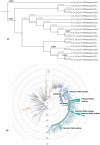Coronavirus Genomes and Unique Mutations in Structural and Non-Structural Proteins in Pakistani SARS-CoV-2 Delta Variants during the Fourth Wave of the Pandemic
- PMID: 35328105
- PMCID: PMC8951394
- DOI: 10.3390/genes13030552
Coronavirus Genomes and Unique Mutations in Structural and Non-Structural Proteins in Pakistani SARS-CoV-2 Delta Variants during the Fourth Wave of the Pandemic
Abstract
Genomic epidemiology of SARS-CoV-2 is imperative to explore the transmission, evolution, and also pathogenicity of viruses. The emergence of SARS-CoV-2 variants of concern posed a severe threat to the global public health efforts. To assess the potential consequence of these emerging variants on public health, continuous molecular epidemiology is of vital importance. The current study has been designed to investigate the major SARS-CoV-2 variants and emerging mutations in virus structural and non-structural proteins (NSP) during the fourth wave in September 2021 from the Punjab province of Pakistan. Twenty SARS-CoV-2 positive samples have been collected from major cities were subjected to next-generation sequencing. Among the 20 whole genomes (GenBank Accession SRR16294858-SRR16294877), 2 samples failed to be completely sequenced. These genome sequences harbored 207 non-synonymous mutations, among which 19 were unique to GISAID. The genome sequences were detected: Delta 21I, 21J variants (B.1.617.2). Mutation's spike_F157del, spike_P681R, spike_T478K, spike_T19R, spike_L452R, spike_D614G, spike_G142D, spike_E156G, and spike_R158del have been detected in all samples where K1086Q, E554K, and C1250W were unique in spike protein. These genomic sequences also harbored 129 non-synonymous mutations in NSP. The most common were NSP3_P1469S (N = 17), NSP3_A488S (N = 17), NSP3_P1228L (N = 17), NSP4_V167L (N = 17), NSP4_T492I (N = 17), NSP6_T77A (N = 17), NSP14_A394V (N = 17), NSP12_G671S (N = 18), and NSP13_P77L (N = 18). The mutation, F313Y in NSP12, detected in the current study, was found in a single isolate from Belgium. Numerous other unique mutations have been detected in the virus papain-like protease (NSP3), main protease (NSP5), and RNA-dependent RNA polymerase (NSP12). The most common non-synonymous mutations in the spike protein were subjected to stability analysis, exhibiting a stabilizing effect on structures. The presence of Delta variants may affect therapeutic efforts and vaccine efficacy. Continuous genomic epidemiology of SARS-CoV-2 in Pakistan may be useful for better management of SARS-CoV-2 infections.
Keywords: NSP; Pakistan; SARS-CoV-2; genome; mutations; variants.
Conflict of interest statement
The authors declare no conflict of interest.
Figures






Similar articles
-
SARS-CoV-2 intrahost evolution in immunocompromised patients in comparison with immunocompetent populations after treatment.J Med Virol. 2023 Jun;95(6):e28877. doi: 10.1002/jmv.28877. J Med Virol. 2023. PMID: 37341553
-
Genomic diversity of SARS-CoV-2 in Pakistan during the fourth wave of pandemic.J Med Virol. 2022 Oct;94(10):4869-4877. doi: 10.1002/jmv.27957. Epub 2022 Jul 4. J Med Virol. 2022. PMID: 35754094 Free PMC article.
-
Genome sequence diversity of SARS-CoV-2 obtained from clinical samples in Uzbekistan.PLoS One. 2022 Jun 27;17(6):e0270314. doi: 10.1371/journal.pone.0270314. eCollection 2022. PLoS One. 2022. PMID: 35759503 Free PMC article.
-
A Biochemical Perspective of the Nonstructural Proteins (NSPs) and the Spike Protein of SARS CoV-2.Protein J. 2021 Jun;40(3):260-295. doi: 10.1007/s10930-021-09967-8. Epub 2021 Feb 24. Protein J. 2021. PMID: 33629236 Free PMC article. Review.
-
Molecular evolution of SARS-CoV-2 from December 2019 to August 2022.J Med Virol. 2023 Jan;95(1):e28366. doi: 10.1002/jmv.28366. J Med Virol. 2023. PMID: 36458547 Free PMC article. Review.
Cited by
-
Genetic characteristics of SARS-CoV-2 virus variants observed upon three waves of the COVID-19 pandemic in Ukraine between February 2021-January 2022.Heliyon. 2024 Feb 7;10(4):e25618. doi: 10.1016/j.heliyon.2024.e25618. eCollection 2024 Feb 29. Heliyon. 2024. PMID: 38380034 Free PMC article.
-
Sequence analysis of the Spike, RNA-dependent RNA polymerase, and protease genes reveals a distinct evolutionary pattern of SARS-CoV-2 variants circulating in Yogyakarta and Central Java provinces, Indonesia.Virus Genes. 2024 Apr;60(2):105-116. doi: 10.1007/s11262-023-02048-1. Epub 2024 Jan 20. Virus Genes. 2024. PMID: 38244104
-
Burnout in health care workers during the fourth wave of COVID-19: A cross sectional study from Pakistan.Ann Med Surg (Lond). 2022 Aug;80:104326. doi: 10.1016/j.amsu.2022.104326. Epub 2022 Aug 7. Ann Med Surg (Lond). 2022. PMID: 35958288 Free PMC article.
-
The identification and phylogenetic analysis of SARS-CoV-2 delta variants in Taiwan.Kaohsiung J Med Sci. 2023 Jun;39(6):624-636. doi: 10.1002/kjm2.12665. Epub 2023 Mar 23. Kaohsiung J Med Sci. 2023. PMID: 36951529 Free PMC article.
-
Comprehensive analysis of clinical indications and viral strain variants among patients infected with SARS-CoV-2 in Inner Mongolia, China.Virus Genes. 2023 Jun;59(3):391-398. doi: 10.1007/s11262-023-01986-0. Epub 2023 Mar 11. Virus Genes. 2023. PMID: 36905534 Free PMC article.
References
-
- Kemp S.A., Harvey W.T., Datir R.P., Collier D.A., Ferreira I.A., Carabelli A.M., Gupta R.K., Meng B. Recurrent emergence and transmission of a SARS-CoV-2 spike deletion H69/V70. BioRxiv. 2021 doi: 10.2139/ssrn.3780277. - DOI
-
- Oude Munnink B.B., Sikkema R.S., Nieuwenhuijse D.F., Molenaar R.J., Munger E., Molenkamp R., van der Spek A., Tolsma P., Rietveld A., Brouwer M., et al. Transmission of SARS-CoV-2 on mink farms between humans and mink and back to humans. Science. 2020;371:172–177. doi: 10.1126/science.abe5901. - DOI - PMC - PubMed
MeSH terms
Supplementary concepts
LinkOut - more resources
Full Text Sources
Medical
Miscellaneous

